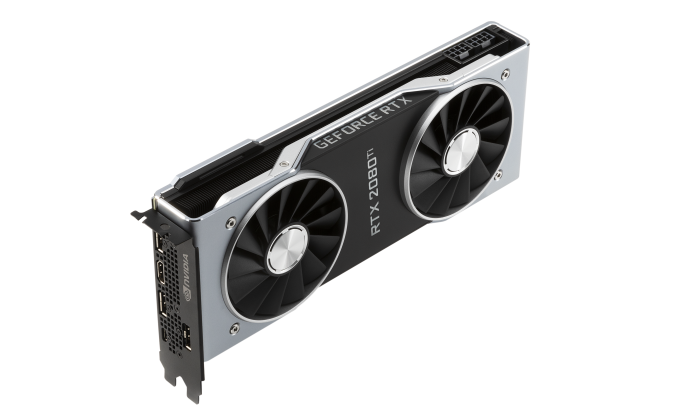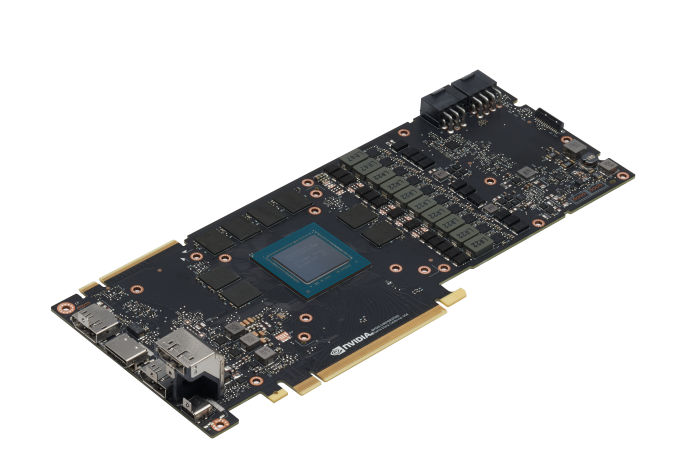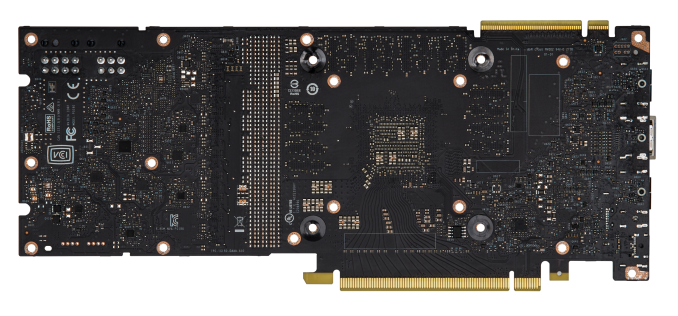The NVIDIA GeForce RTX 2080 Ti & RTX 2080 Founders Edition Review: Foundations For A Ray Traced Future
by Nate Oh on September 19, 2018 5:15 PM EST- Posted in
- GPUs
- Raytrace
- GeForce
- NVIDIA
- DirectX Raytracing
- Turing
- GeForce RTX
Meet The GeForce RTX 2080 Ti & RTX 2080 Founders Editions Cards
Moving onto the design of the cards, we've already mentioned the biggest change: a new open air cooler design. Along with the Founders Edition specification changes, the cards might be considered 'reference' in that they remain a first-party video card sold direct by NVIDIA, but strictly-speaking they are not because they no longer carry reference specifications.
Otherwise, NVIDIA's industrial design language prevails, and the RTX cards bring a sleek flattened aesthetic over the polygonal shroud of the 10 series. The silver shroud now encapsulates an integrated backplate, and in keeping with the presentation, the NVLink SLI connectors have a removable cover.
Internally, the dual 13-blade fans accompany a full-length vapor chamber and component baseplate, connected to a dual-slot aluminum finstack. Looking at improving efficiency and granular power control, the 260W RTX 2080 Ti Founders Edition features a 13-phase iMON DrMOS power subsystem with a dedicated 3-phase system for the 14 Gbps GDDR6, while the 225W RTX 2080 Founders Edition weighing in with 8-phases main and 2-phases memory.
As is typical with higher quality designs, NVIDIA is pushing overclocking, and for one that means a dual 8-pin PCIe power configuration for the 2080 Ti; on paper, this puts the maximum draw at 375W, though specifications-wise the TDP of the 2080 Ti Founders Edition against the 1080 Ti Founders Edition is only 10W higher. The RTX 2080 Founders Edition has the more drastic jump, however, with 8+6 pins and a 45W increase over the 1080's lone 8 pin and 180W TDP. Ultimately, it's a steady increase from the power-sipping GTX 980's 165W.
One of the more understated changes comes with the display outputs, which thanks to Turing's new display controller now features DisplayPort 1.4 and DSC support, the latter of which is part of the DP1.4 spec. The eye-catching addition is the VR-centric USB-C VirtualLink port, which also carries an associated 30W not included in the overall TDP.
Something to note is that this change in reference design, combined with the seemingly inherent low-volume nature of the Turing GPUs, cuts into an often overlooked but highly important aspect of GPU sales: big OEMs in the desktop and mobile space. Boutique system integrators will happily incorporate the pricier higher-end parts but from the OEM’s perspective, the GeForce RTX cards are not just priced into a new range beyond existing ones but also bringing higher TDPs and no longer equipped with blower-style coolers in its ‘reference’ implementation.
Given that OEMs often rely on the video card being fully self-exhausting because of a blower, it would certainly preclude a lot of drop-in replacements or upgrades – at least not without further testing. It would be hard to slot into the standard OEM product cycle at the necessary prices, not to mention the added difficulty in marketing. In that respect, there is definitely more to the GeForce RTX 20 series story, and it’s somewhat hard to see OEMs offering GeForce RTX cards. Or even the RT Cores themselves existing below the RTX 2070, just on basis of the raw performance needed for real time ray tracing effects at reasonable resolutions and playable framerates. So it will be very interesting to see how the rest of NVIDIA’s product stack unfolds.
















337 Comments
View All Comments
mapesdhs - Thursday, September 27, 2018 - link
Does the site earn anything from your reading their articles? Just curious.sing_electric - Thursday, September 20, 2018 - link
I really wonder how well raytracing will be implemented in the next 1-2 years. My bet is that for many of the titles Nvidia's announced, the effects will be limited and sort of gimicky, and the real benefits will come with titles that are starting development now (or, more likely, in a few months, when devs can look at how the 1st attempts at using RT faired).If my hunch is right, then that means that the RT features are likely to be of little practical use in this generation, since the real benefits won't come until some point after Nvidia's next-gen (7nm? 5?) chips come out with much-improved performance.
MadManMark - Thursday, September 20, 2018 - link
It sounds like the 2080 TI at maybe 1440 might be viable for RT. But yeah, for the most part this is about the future, and starting to get some games out there so for future releses there is not the "chicken & egg" problem they have now (no games to use it for, but reason there are no games is there are no cards to use it).Nvidia clearly sacrificing short-term profitability to establish this base; notice how the 2080 is both priced & performs about the same as the 1080 Ti. With the larger die size despite 12nmFF, driver development costs, etc, there is little doubt in my mind that Nvidia will be making a bigger margin on the 1080 Ti than the 2080. But they want to make it cheap enough so that, even if there is little to gain RIGHT NOW from buying 2080 instead fo 1080 Ti, there is also little lost either.
milkod2001 - Thursday, September 20, 2018 - link
It will have to be AMD who also jumps on raytracing thing first then maybe game developers will take it seriously.MadManMark - Thursday, September 20, 2018 - link
"Bartender, I'll have what milkod2001's having!" ;)El Sama - Thursday, September 20, 2018 - link
RTX 2080 not worth buying right now, 1080ti is cheaper (lol), cooler and performs equal. RTX 2080ti is a 1200+ Card that is around 60% price increase from 1080ti for a 25-28% performance increase? How is that a good purchase? Neither of them are worth buying right now.Toadster - Thursday, September 20, 2018 - link
decisions - 24 monthly payments for an iPhone XS Max? or GTX 2080Ti :)milkod2001 - Thursday, September 20, 2018 - link
Get iPhone if you want to be cool guy, you cannot put RTX 2080ti into your pocket :)Arbie - Thursday, September 20, 2018 - link
THANK YOU for the Ashes of the Singularity benchmark results. The deltas may not translate to other games but show me exactly what to expect from an upgrade.darckhart - Thursday, September 20, 2018 - link
But NVIDIA's key features - such as real time ray tracing and DLSS - aren't being utilized by any games right at launch. In fact, it's not very clear at all when those games might arrive, because NVIDIA ultimately is reliant on developers here.In the Star Wars Reflections demo, we measured the RTX 2080 Ti Founders Edition managing around a 14.7fps average at 4K and 31.4fps average at 1440p when rendering the real time ray traced scene. With DLSS enabled, it jumps to 33.8 and 57.2fps
Direct quotes from article. Price premium for NV tech that (1) will not be in games at launch and may have months of buggy implementation from early adoption and may not have widespread adoption, (2) needs extreme help from DLSS to have usable framerates. Should've been named DTX not RTX.